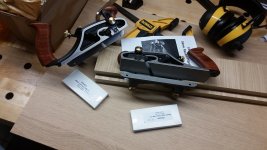ear3
Member
I have to mill some custom moulding for a project -- I've made a version of the profile before working with a tablesaw (before I started working with handplanes), but it was a real bear to sand out the blade and burn marks, so I'm thinking about getting a rabbeting plane to assist. I would be using the plane at the very least to clean up the blade marks on the wide rabbet (b/w 1 1/2 to 2" wide) that is part of the profile, but depending on if the plane I end up getting has depth stop capabilities, like the Veritas skew rabbet, I might even attempt to make the majority of the profile from scratch (I don't have moulding planes, so I would still have to mill the curved portions of the profile with a router).
I'm looking at the veritas planes, specifically the jack rabbet and the skew rabbet. So my question is about what people find more useful to have in their plane arsenal. I was initially gravitating to the jack rabbet, because I'll be doing such wide rabbets and on stock up to 4 ft. in length. But since I already have a low angle jack plane, I'm wondering how often I would otherwise reach for the rabbet version in the future:http://www.leevalley.com/en/Wood/page.aspx?p=69851&cat=1,41182,41192&ap=1
So I was thinking maybe it's better to get an even more specialized rabbet plane like the skew rabbet. I really like the depth stop, which would give me a precision that the jack version might not have -- and also the smaller footprint of the skew would allow work with smaller stock. But the rabbet size of the skew plane seems limited when compared to the jack, (according to spec the max rabbet with the fence is 1 1/2" -- though I could obviously freehand it further without the fence if necessary):http://www.leevalley.com/en/Wood/page.aspx?p=59999&cat=1,41182,41192&ap=1
First world problems, I know, but I've been going back and forth on this in my head for a few days without being able to decide.
I'm looking at the veritas planes, specifically the jack rabbet and the skew rabbet. So my question is about what people find more useful to have in their plane arsenal. I was initially gravitating to the jack rabbet, because I'll be doing such wide rabbets and on stock up to 4 ft. in length. But since I already have a low angle jack plane, I'm wondering how often I would otherwise reach for the rabbet version in the future:http://www.leevalley.com/en/Wood/page.aspx?p=69851&cat=1,41182,41192&ap=1
So I was thinking maybe it's better to get an even more specialized rabbet plane like the skew rabbet. I really like the depth stop, which would give me a precision that the jack version might not have -- and also the smaller footprint of the skew would allow work with smaller stock. But the rabbet size of the skew plane seems limited when compared to the jack, (according to spec the max rabbet with the fence is 1 1/2" -- though I could obviously freehand it further without the fence if necessary):http://www.leevalley.com/en/Wood/page.aspx?p=59999&cat=1,41182,41192&ap=1
First world problems, I know, but I've been going back and forth on this in my head for a few days without being able to decide.




